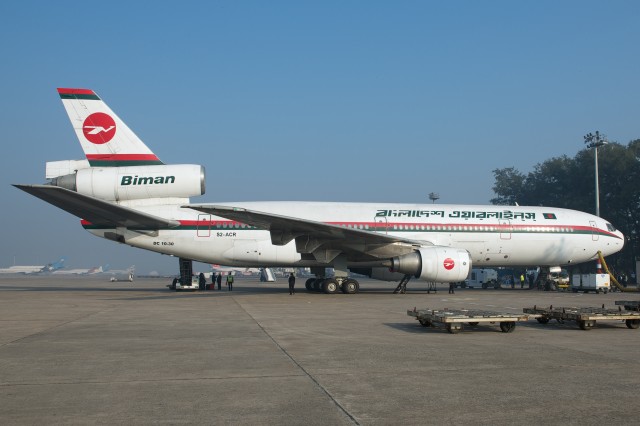
S2-ACR on the ramp at Hazrat Shahjalal International Airport – Photo: Bernie Leighton | AirlineReporter
So, you want to fly on a DC-10 in 2014? Bad news. Very bad news. I hate to tell you, but that ship has sailed. Until a few days ago, that was not the case.
Arriving into Dhaka at 4:51 am, the first thing I noticed was the haze. I really have no idea where it comes from – it seems to burn off by the afternoon. The next thing I noticed about Bangladesh was how easy it was to get a visa on arrival. If you were wondering, Dhaka is only certified for CAT-1 ILS approaches. This has been known to wreck timetables and force diversions to far off points.
The first thing I noticed was that the airport has a great degree of 1970’s Marxist-chic to it. I admit, the airport actually opened for passenger use in the 1980’s- but there were many stop-and-start construction efforts that make it, in some ways, the most amazing the airport was ever (semi) completed.
I had exactly twenty four hours in Dhaka and almost no idea what to expect. Dhaka’s a very fluid city; the buildings may look the same, but the traffic is a variable no one should mess with! Thankfully, the hotel shuttle never seemed to have much of a problem finding either a semi-paved or unpaved road to beat the chaos. The other thing not included in travel brochures about Dhaka is that no matter what hour of the day, someone is riding their car horn.
But I wasn’t in Dhaka for the traffic or interesting architecture. I was there to take the last passenger DC-10 flight ever.
After operating a JED-CGP-DAC service, Biman towed S2-ACR (the last passenger DC-10) into their hangar, where they cleaned it, especially the cargo hold (which stank of fish after doing tons of HKG cargo runs with export-grade seafood). Afterwards, it was parked on a hard stand not too far from the main terminal.
The departures hall in Dhaka is more or less exactly what’d I expected it to be. I deeply, wish I had been brave enough to take a photo of the police officer with an SKS sitting next to a soldier with what I could only describe as an Ishapour Arms SMLE. No idea on the origin of the SKS, but this one had a bayonet mount and going any closer seemed like a very poor decision.
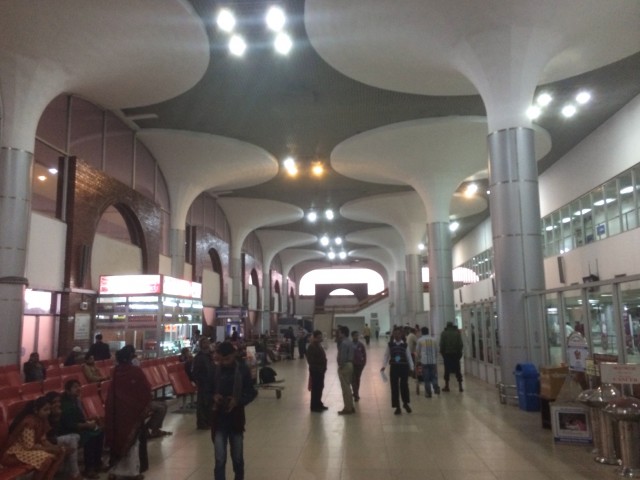
The check in hall of Hazrat Shahjalal International Airport – Photo: Bernie Leighton | AirlineReporter
Once through exit customs, I realized that it would be a good idea to check out a lounge. Not sure which of the five I actually ended up in. I eventually just walked in a door where I could use my Priority Pass. Whatever the case, it had a rather colonial southeast Asian feel to it, and the brownies were delicious. Soon, I was headed to gate 2A before boarding a 1970’s-vintage Japanese bus.
I love 1970’s buses, period, so the red chic interior was well received and I could not complain about the more or less a free ramp tour on our way to the DC-10.
Two minutes later, S2-ACR began to fill my field of view – but alas it was backlit! Not to worry, the Bangladeshis are extremely accommodating and friendly. It simply took a point and a wave to get me situated, properly, around the lit side of the aircraft. They were even kind enough to move some otherwise unpleasant ground equipment that would have cluttered the shots.
There is not much that can motivate me from leaving the ground, taking photos of a DC-10, except the ability to board one. 28 hardcore aviation enthusiasts, myself included, were invited to go up the airstairs. We boarded a long time after the 25 crew. For some, it was just another day – they were getting off in Kuwait to meet an arriving 777-300ER, but for me, this was going to be an epic journey.
Most passengers would probably choose an enclosed doorway, but boarding via airstairs and being able to glimpse the third engine was amazing.
Today, Biman’s “death cruisers” are not the flagships they were in 1988 when the so-called “New Era’ was delivered. They’re for labor traffic – and goodness me – are there a lot of seats! 390, in fact (more than a United Airlines 747). Then again, on the flights they were using the DC-1o for, it’s not like the 30’ or less seat pitch mattered that much.
We still were flying an empty aircraft full of spare parts to Birmingham, with a tiny amount of revenue traffic. I am told Biman is not thrilled with the performance of this flight, but such is the double-edged sword of offering nine scenic tour flights around the UK. I am also worried that, much like PNG, Bangladesh’s old reputation proceeds it.
I can be honest and say, it’s probably not as safe as most people would like it to be, but going out during the day I never felt in any danger. If anything, I felt like I was extremely well taken care of.
Start up took quite some time. ACR’s APU is bust. In Bangladesh, you just make due with a ground start cart and then sequentially starting the engines until there is enough air in the system to crank the next fan over.
There are also some other anomalies. You know, comforting things like random non-structural corrosion. Company policy is to not deploy the thrust-reverser on the number two engine outside of Dhaka. It may get stuck otherwise. The aircraft also gets notably colder over the course of the flight. But none of this seems to matter, I was about to experience history.
Startup was impressive, especially as I had flown in aboard a GE-engined A330. The A330 may have CF-6 engines too, but those CF-6s have at least 30 years of advancement. The CF-6, after all, evolved from the military TF-39 engine used on the C-5A Galaxy heavy transport aircraft. I deployed my handy sound pressure measurement app for takeoff. Consistent readings of about 88 decibels. Recall, a 737-800 has a sound pressure in the cabin on take off of 83dB; a DC-10 is almost twice as loud. This is a good thing — at least for me.
We soon taxied to Hazrat Shahjalal’s Runway 32 for departure. The whole way along, all the airport and Biman employees were happily waving. The DC-10, though long out of fashion, was really the first aircraft that let Biman focus on what it needed to be as an airline. Though long-haul routes were often politically motivated, when the aircraft moved to a more high-density configuration it was amazing at moving the guest worker flow back and forth to Bangladesh, and sometimes even Nepal.
To the airline, it’s simply too expensive to run, especially compared to their brand new 777-300ERs which they can easily load with workers. Their 77W product also offers business class, something the DC-10 has not done for at least a decade. It is an extensive upgrade in terms of product, capacity, cargo capabilities, and cost savings.
Takeoff for Kuwait City was sporty. This aircraft, even when loaded with fuel and spares still had almost no self-loading cargo, and even less baggage. Since it has been so long since I last flew the ten, I have no idea if we de-rated the take-off in any way, but I highly doubt it. It felt as if we went whole hog.
It became clear which part of the crew were working for the money, and which were working because they’d never get to do this again and will greatly miss this loose collection of bolts flying in formation.
To describe cruise, I would look no further than the term sturdy. Seriously, this aircraft is immobile as a boulder. Sure, if you head to the aft cabin lav, it’s a bit more of a tail-kicking, yaw-damper, momentous bouncing around experience. Of course, I spent a lot of time in the aft cabin, because my measurements indicated it was about twice as loud as my seat (18A.)
I say my seat, but with so few people on board, no seat was assigned. Indeed, the middle rows of five became perfect beds. Except, because of my jetlag and excitement, I could not sleep. Another point of misery is just how dry the cabin was. I drank copious amounts of water, and still felt parched. My eyes itched, my skin felt like it was going to crack. Compared to the DC-8, even (an older aircraft by 20 years) this plane was practically leaching water from my skin. Sometimes I think we’ve gone the wrong way since older aircraft, in a quest to drown out any kind of noise, killing most kinds of aircraft diversity. But better cabin humidity, pressure, and climate control? Sign me up!
Eventually, on this six-and-a-half hour flight to Kuwait, it was time for lunch. I had the Chicken Daal. Bangladesh knows how to do a daal, just as a general fact.
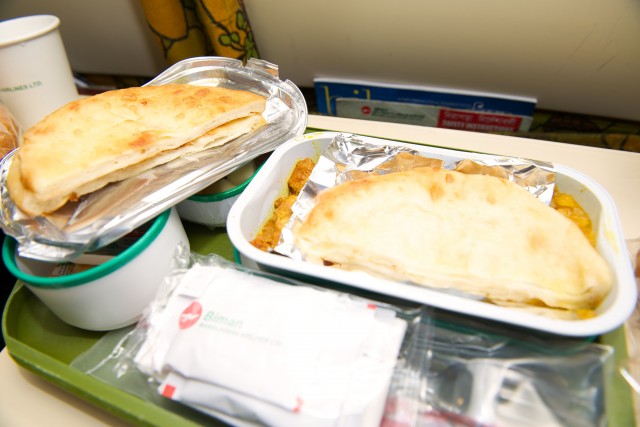
The chicken and daal curry that was the first meal aboard BG1015 – Photo: Bernie Leighton | AirlineReporter
After lunch, it was time to head on up to the flight deck. It has the smell that someone had recently been smoking cigarettes, which I was hoping came more from the history of the aircraft than its present.
The flight deck is exactly how I remembered it from the days when Canadian had DC-10-30s. It was also one of the most well-maintained areas of the aircraft. The real highlight came from watching an Emirates 777-300ER fly about 2000 feet above us and one mile ahead. Those windows, unlike the ones in the passenger cabin, are spotless.
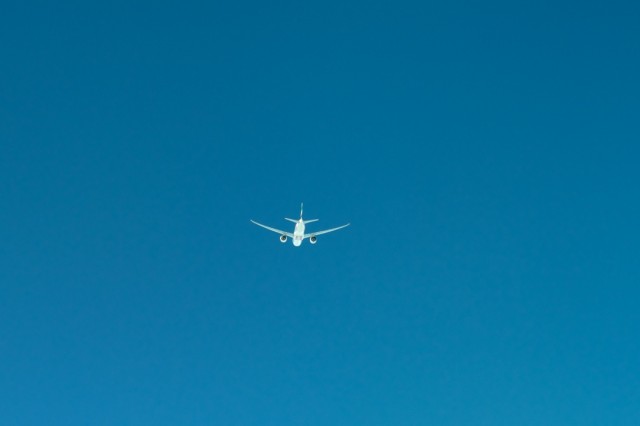
An Emirates 77W cruising reasonably close to and above us – Photo: Bernie Leighton | AirlineReporter
Speaking of Canadian, there are numerous spare parts within ACR that must have come to Biman second or third-hand from them. The front economy cabin is loaded with numerous signs for ’œClub Empress’ on the overhead bins.
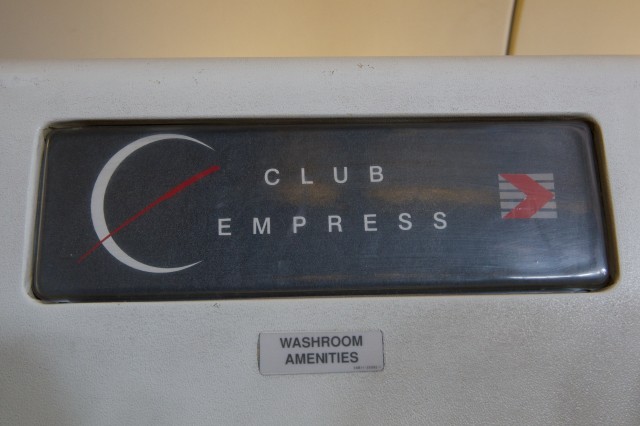
Old-fashioned Canadian Airlines business class overhead bins – Photo: Bernie Leighton | AirlineReporter
Roughly one hour after lunch, I could hear the engines begin to spool down and our attitude begin to lower. It was time to descend for our fuel stop in Kuwait. Descent was a little rough, but never unmanageable or annoying.
Kuwait City is right on the coast, so there is plenty of on and off-shore breezes to make the air a tad rough. Other than that, the descent was fairly routine, if pleasantly loud. The real fun came in the landing. It’d seem as if the crew desperately wanted to get off the runway by a certain exit as the brakes were slammed on. We stopped extremely quickly, even using two thirds of the thrust reverse capacity. So forceful was our stop that it actually sent some cabin items flying. I was impressed.
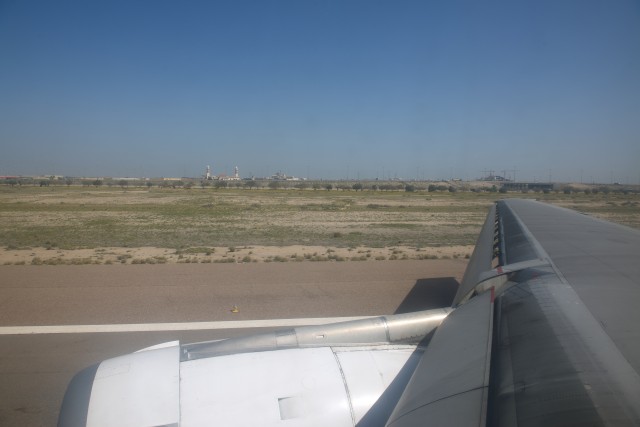
Pulling on to the taxiway in Kuwait city after a very short landing – Photo: Bernie Leighton | AirlineReporter
I shall continue this saga later. It will cover the flight from Kuwait City to Birmingham and the final DC-10 passenger flight ever.
Continue with my adventure with Part 2: Flying from Kuwait to Birmingham
Be sure to also enjoy the coverage of the last DC-10 flight with our friends at Airchive.com.
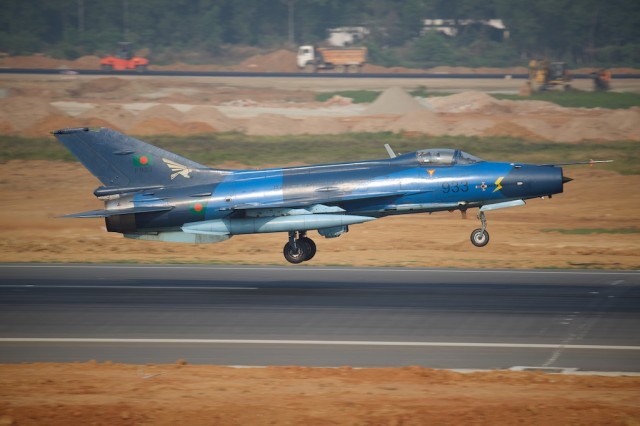
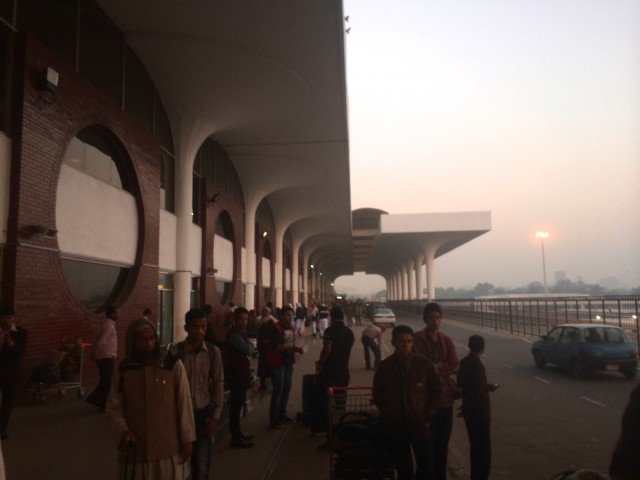
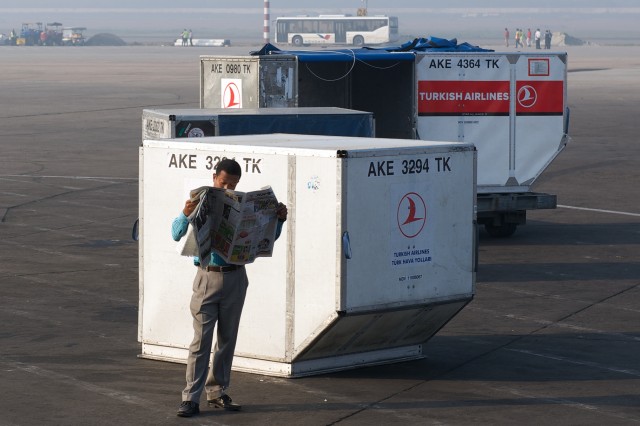
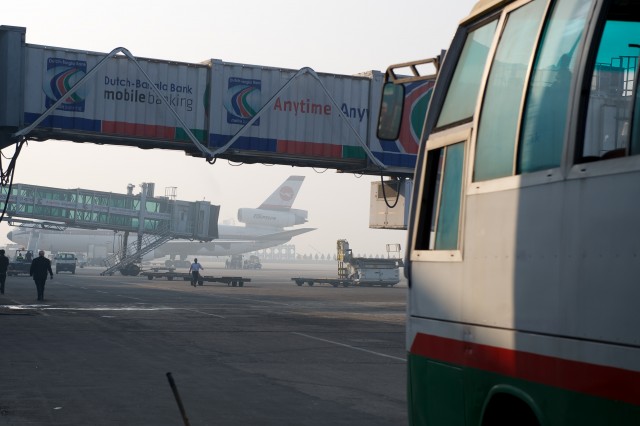
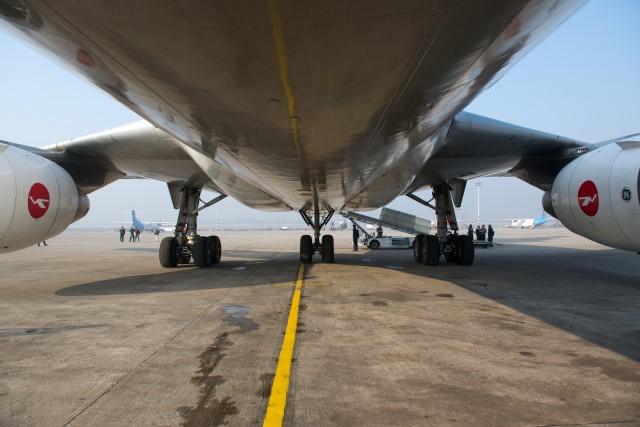
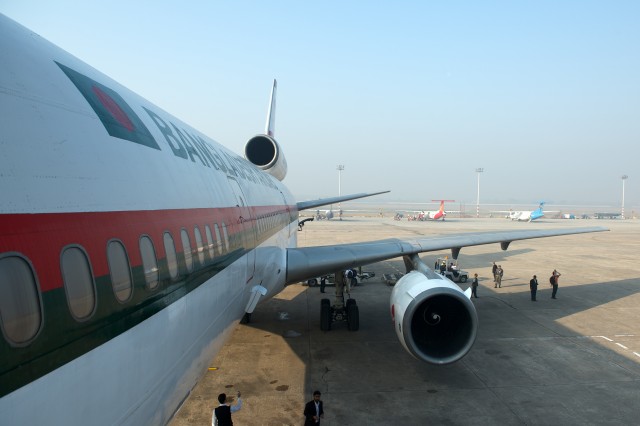
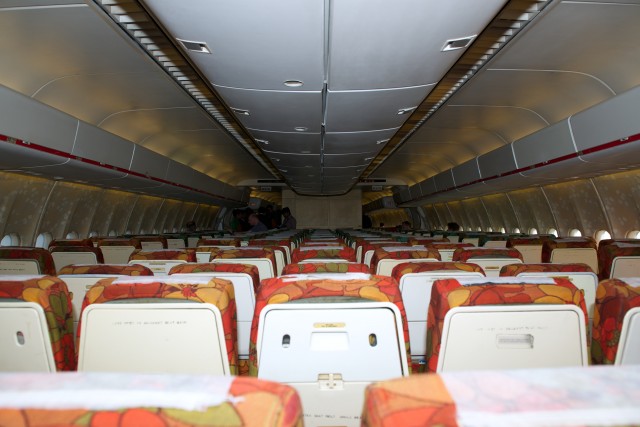
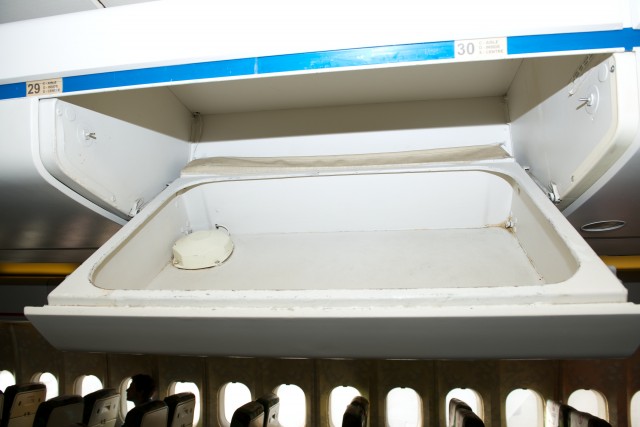
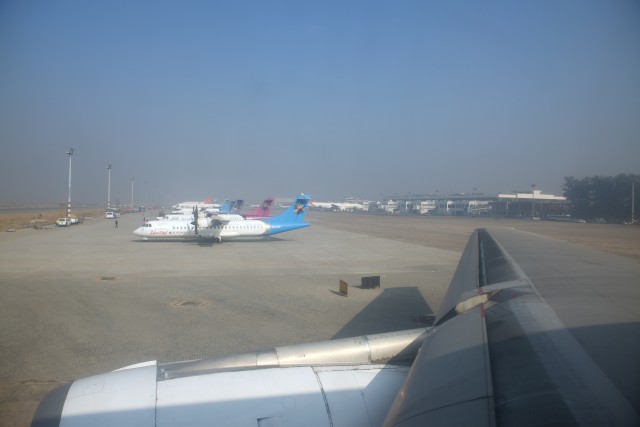
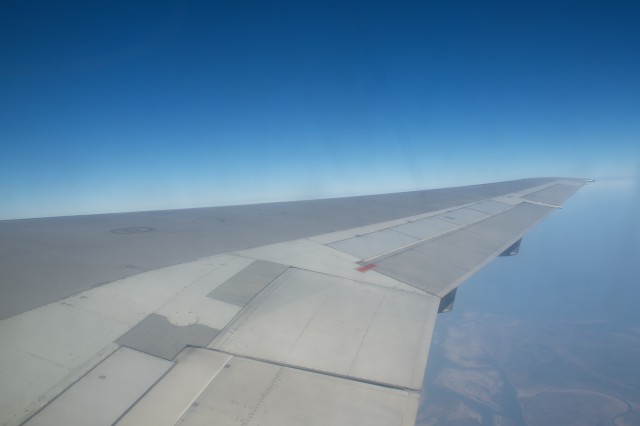
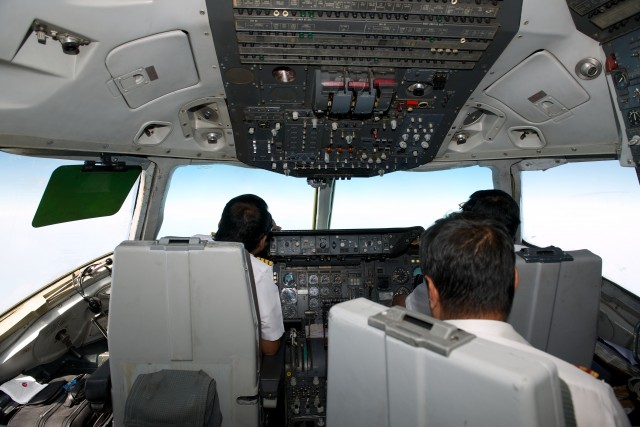
Great reporting Bernie. I can’t believe they have 390 seats in there. We used to have 380 in Cal Air/Novair DC-10-10’s and that was tight, particularly the aisle seats in the 1st 4/5 rows where the seat rails curve inward towards the nose. I’m sad not to be in BHX over the weekend to see her flying. I’ll see what the weather’s like on Sunday and might make the effort.
A great and very current report. That said, I guess in the rush to publish, the editing enhancements introduced at Airline Reporter were skipped. No real harm, but with writing quality is not up to Bernie’s best; several points just don’t make sense. I’m looking forward to the reports of the final leg and sharing the fun. I’m still shocked that Biman would operate with but 30 revenue seats, but they already had a big PR program in progress, so fly they must. As notes somewhere else, I too am shocked that so many ICAO security requirements were excused, but WTF, it as an historic event, at least for AvGeeks. Glad that you were able to make the trip and share the details with readers.
Oh yeah, tight is an understatement. I wish I could have done it more justice in describing just HOW tight it was – but I was writing this piece both on the plane and shortly after landing/passing out from jetlag in BHX. I think the most interesting thing about the Biman tight seats is that they have a hard, yellowed, plastic divider under the aisle-facing armrest. Lord help you if you are a passenger of size I suppose!
In Biman DC10, cabin seating configuration is 314 all economy, not 390.
Very interesting story , you were vaery fortunate to be allowed on the flight deck !
Sorry , i meant Very !
Biman DC10 seat capacity was 314 normally but it could be increased to 390 by realigning the seats for short distance flights with less leg room and comfort.
Sir I am so excited to read your report on the next leg kuwait – Birmingham as I am the mechanic from kuwait who departed the aircraft on its final leg . Reading the dhaka kuwait leg was a treat .. Thank you .